Coastal and offshore rowing
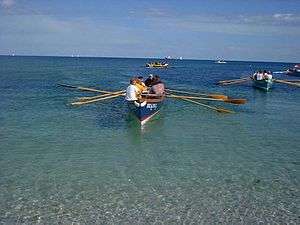
Coastal and offshore rowing is a type of rowing performed at sea. Due to the harsher conditions encountered, the boats are wider and more robust than those used on rivers and lakes. In North America this sport is often called Open Water Rowing.
International competition
The sport of coastal and offshore rowing is thriving across Europe, though at present most British sea rowing is "traditional" fixed seat rowing and competition is of a regional nature. France is leading the development of modern sliding seat seagoing boats, "Yoles", and National Competition here is well established with FISA, the worldwide regulatory body for rowing, encouraging the expansion of the sport to other countries.
As the FISA World Coastal Rowing Challenge is becoming established, the use of the French Yole is gaining in popularity and most European countries are beginning to adopt this standard class.
Since 2007 the competition has been renamed as the FISA World Club Coastal Rowing Challenge,[1] thus opening the event to all Club rowers without pre-qualification and acknowledging Coastal rowing's very participatory nature. FISA is further committed to endorsing sea rowing traditions by encouraging rough water competition requiring seamanship and navigation skills, in addition to fine technique.
Spain
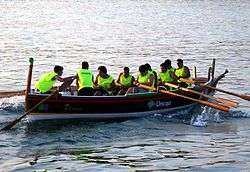
The Spanish seafaring tradition has left a very important heritage of coastal rowing scull boats, in another time devoted to tasks of fishing, and now used for sport and leisure activities. Among the best known include the “traineras” and “bateles”, typical of northern Spain, the “llaüts” and “faluchos”, from the East regions of Spain, and the “barcas de jábega” in the Southeast Spanish Mediterranean coast.
Each summer in the city of Malaga and nearby villages are beautiful races of seine boats. Currently there are seven oars, with a length between 7 and 9 m and weighing between 850 and 1150 kg. Currently clubs in the province of Malaga are represented by a commission named COBARJA which coordinates its activities and races.
North America
In North America (where the sport is known as "open water rowing"), coastal rowing typically involves longer, lighter and faster boats, more similar to flat-water racing shells, yet designed for stability and safety in chop, wakes and swells. Stability is achieved by a broader waterline beam with safety ensured through the use of positive flotation, self-bailing capacity, supplemented by the rower's seamanship skills. North American boats do not conform to the minimum standards established by FISA, because they are too long and do not weigh enough.
Open water boats are used for racing, recreation, touring, health and fitness and serve the adaptive rowing community. The non-weight bearing nature of the sport, versatility and stability of recreation and open water rowing equipment attracts a wide age range of rowers with enthusiasts rowing well into their 80's. Open water rowing in North America is very popular on the Chesapeake Bay, in coastal towns of Massachusetts, Long Island Sound communities in Connecticut and New York, California, and Washington.
Open Water Racing is found on both the west and east coasts of the U.S. International Recreation and Open Water Rowing Association's based in New England serves as a community for recreational sliding seat rowers of all ages to enjoy camaraderie, wellness and an appreciation of nature through educational, touring and competitive events.
'Sound Rowers and Paddlers',[2] sponsors races from February until October around Puget Sound, Washington. Their racing began in 1978 with the Round Shaw Island Race. The club employs a photographer who captures the racing from the water during the races, which cover from 6 to 26 miles. These photos are posted on the club's website and provide a vivid overview of the nature of these races. Open water racing in the San Francisco area is supported by the Open Water Rowing Center in Sausalito which was founded over twenty years ago and the Bay Area Whaleboat Rowing Association since 1982, while offshore rowing in the Monterey Bay area is available through the Santa Cruz Rowing Club.
Open water racing in New England is also supported by Norwalk River Rowing Association in Norwalk, CT, Hull Lifesaving Museum, Hull, MA, River Rowing Association in Nyack, NY, Little Harbor Boathouse Open Water Rowing Center in Marblehead, MA and the Cape Ann Rowing Club, with the number of open water racers growing rapidly. The pre-eminent open water race in New England is the Blackburn Challenge and one may find open water events in New England and Long Island Sound sponsored by fast growing internet groups called Rowing For All Meetup.
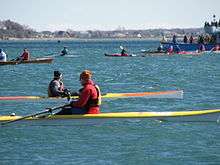
Starting in 2006. the North American Open Water Rowing Championship race was contested at new locales each year. The first race was in Seattle, next at Cape Ann, Massachusetts, and then at San Francisco. The venue for 2011 was the Blackburn Challenge—a 20-mile course circumnavigating Cape Ann off Gloucester, Massachusetts.[3] This event brought together the best open water racers from across the continent.[4] The NAOWRC race was discontinued after 2011.
The Whitehall Spirit Rowing Club of Victoria, Canada is a recent open water rowing club formed in 2010 and members row in slide seat whitehall rowing boats.
ClubLocarno of Vancouver, Canada maintains a fleet of single and double open water sculls and runs the recreational open water rowing school at the Jericho Sailing Centre.[5]
South America
In South America Coastal Rowing first occurred in Perú, in the Club de Regatas Lima. In the atlantic ocean, there is a small group of coastal rowers in the Escuela de Remo de Punta Carretas in Montevideo, Uruguay.
Great Britain
The Cornish Pilot Gig Association is by far the largest British sea rowing group and preserves a tradition using both original and new boats made to a closely controlled specification. The CPGA has seen a huge continuing growth over the past decade or so and new boats are constantly being built to satisfy the demand. The Cornish Gig has been adopted by rowers in the Netherlands and there is a successful Gig club in Wales.
Other groups thrive throughout British coastal regions: from Shetland in the North, Whitby and Scarborough on the North Sea; Seine boat rowers on the Teign, to the Channel Islands
Following some forty years of design development using chined plywood hulls, both Guernsey and Jersey are now importing superior double and single washdeck fibreglass boats from France. Semi washdeck, chined, double skinned, plywood quads, were under construction in Guernsey during the first decade of this century, though none were built in 2009. A Guernsey designed carbon fibre double and quad appeared in 2008. This design went into production in the UK in 2009, with a fleet being built for the 2009 world championships in Plymouth. Boat building in Jersey ceased in the '80's. All Channel Island boats are now built to FISA dimensions.
The open Welsh Celtic Longboat style craft introduced in the mid 70s has since the early 2000s evolved into a double skinned "washdeck" boat and now is the only design under construction. From 2006 FISA dimensions are followed in hull design.
Scotland
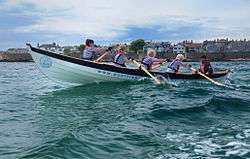
The Scottish Coastal Rowing Association was founded in May 2010, adopting the St. Ayles Skiff as the standard hull for its races. The St Ayles is built from a plywood kit, with the express intention of keeping the construction costs to a minimum to increase the uptake. The design was first launched in October 2009; by mid-2015,163 kits had been sold in the United Kingdom with over 100 launched. The class is also gaining popularity in Australia, New Zealand, and in North America.
The first world championships for the St Ayles was held at Ullapool in Scotland in July 2013 with 30 skiffs in attendance. The next "Skiffieworlds" will be held in Strangford Lough, Northern Ireland in 2016.
Competition thrives, whether a League system, or "one off" Challenges. The 22-mile (19 nmi; 35 km) London Great River Race is the major British event for traditional boats attracting up to 350 crews, but there are many regular events throughout the long March to October season. A similar event takes place in Cork, Ireland every year, the Ocean to City[6] race is 15 nautical miles (28 km; 17 mi) traversing Cork harbour. In 2006, 150 traditional boats completed the event.
Wales
The Welsh Sea Rowing Association, for instance, organises a total of 21 offshore and estuary events each year. These range from 5-mile (4.3 nmi; 8.0 km) league races to the 90-mile (78 nmi; 140 km) Celtic challenge rowing race, an epic Irish Sea crossing.
The annual Interceltic Watersports competition features, amongst other events, sea rowing using both traditional and modern craft. This has greatly helped in the development of open water competition amongst rowers from the ten Celtic nations and Welsh rowers now compete across Europe, representing Great Britain in France, Italy, and Spain.
Celtic Sea rowers in Wales and Ireland have adopted modern designs of fixed seat boats, loosely based on the Irish Currach,[7] which itself is still used by sea rowers in both countries and the Cork Yawl, which was the base design for the Celtic Yawl used for the All-Ireland Coastal Rowing Championships run by the Irish Coastal Rowing Federation.
South Coast
Competitive sliding seat coastal rowing has taken place on the South coast of England since the late 19th century. It is regulated by two bodies, The Hants and Dorset Amateur Rowing Association[8] which regulates competition from Swanage to Southsea, and The Coast Amateur Rowing Association (Worthing to Herne Bay). Both bodies operate under the auspices of the national governing body British Rowing.
In common with British flat water rowing, regattas are held in the summer months with races of around 2,000 metres (1.1 nmi), with longer processional head races held in the winter months in more sheltered river and estuary waters. The points system to categorise athletes is slightly different but compatible with the flat water points system, with the same separate statuses for sweep and sculling.
Talented athletes from HDARA and CARA clubs have found their way into the ARA's national team programmes for flat water/ Olympic rowing, as the similarity in equipment used and race distance lends itself quite well to changing between the two disciplines. Most CARA and HDARA clubs have flat water boats as well as their coastal boats, and club members often also compete in river events.
Coastal boats used are coxed IVs, coxless pair and single sculls for championships, with double sculls and mixed crews used for non championship or fun events. All boats are wider than their river counterparts with higher freeboard to cope with coastal conditions. The fours are restricted to 30 feet (9.1 m) in length (the dimensions of an old railway carriage which was used to transport the equipment before the use of cars and trailers) and the pairs to 22 feet 6 inches (6.86 m). They have staggered seating to accommodate the rowers in the reduced length and spread the weight across the width of the boat for stability. The reduced dimensions of the boat also aid in the buoy turn, as unlike river races the start and finish points for these forms of coastal events are the same point and require a 180° "spin" around a marker (either a buoy, or a float with a flag on top called a 'dan').
Regatta races are typically conducted along the beach, round a buoy (one for each competitor, moored in a line), and back (1,000 m or 0.54 nmi both ways). Regatta locations vary from the rough and exposed, such as Bournemouth or Shanklin to the more sheltered, such as Southampton Water.
Crews from the Hampshire and Dorset and the Coast Amateur rowing association come together along with those from the West of England ARA each year for the South Coast Rowing Championships which is held alternately in Coastal and River Fine boats.
Ireland
Coastal rowing in Ireland consists of a number of associations from around the coast of Ireland; the south west coast covering counties Cork and Kerry has the highest concentration of rowing clubs and is governed by the Coastal Rowing Association (CRA), the South West Coast Yawl Rowing Association (SWCYRA), and the Kerry Coastal Rowing Association (KCRA) & the South & Mid Kerry Rowing Board (SMKRB), the Irish Sea from Drogheda in Co. Louth, heading South as far as Courtown in North Co. Wexford is governed by the East Coast Rowing Council, while Antrim coast is covered by the Antrim Coast Rowing Association (ACRA), and Wexford is governed by Slaney Rowing Association (SRA). Donegal clubs represented by the Donegal Coastal Rowing Association affiliated to the Irish Coastal Rowing Federation in 2013.
Recently the Irish Coastal Rowing Federation (ICRF) affiliated itself to Rowing Ireland (the governing body of Olympic type rowing in Ireland) and become the Coastal Division of a much enhanced Rowing Ireland. This watershed in Irish Rowing history sees the two organisations merging into a single entity with a combined membership of approximately 150 clubs and in excess of 6,000 registered rowers, this allows the combined organisation to offer rowing in almost every corner of the country. Although coming under the umbrella of Rowing Ireland, the Irish Coastal Rowing Federation will continue to administer all aspects of coastal rowing in Ireland.
Throughout the summer season the different associations of coastal rowing in Ireland hold championships using either the traditional boats of the area of the Celtic Yawl, this season generally ends with the annual All-Ireland Coastal Rowing Championships, which involves up to 500 crews each year and is believed to be one of the biggest coastal rowing regattas in the British Isles and Europe. The Irish Coastal Rowing Federation[9] is the governing body for coastal rowing in Ireland. The Celtic Yawl, which was designed by Rob Jacob and introduced in 2002, is used as a bridge to link the various Irish classes of boats from the East Coast Skiffs, the Cork yawls, the Kerry four oars, Wexford/Slaney cots, Antrim gigs and Donegal skiffs.
In July 2016 the World community, coastal rowing championships "Skiffie Worlds 2016" was held on Strangford Lough. The event was attended by 50 clubs from Scotland, England, Northern Ireland, the Netherlands, The United States, Canada and Tasmania racing St. Ayles Skiffs. Racing, which took place over several days, was held over a 2 km course on Strangford Lough at Delamont Country Park.[10]
Australia
The sport of open water rowing is in the early stages in Australia. The American model of lightweight open water boats is generally being adopted. Most Open Water rowing is done for recreation, but competition will soon be established and the sport is expected to expand.
Surf boat rowing is very popular in Australia and New Zealand and to a lesser extent South Africa. Usually associated with surf lifesaving clubs surf boat crews are trained in life saving skills as well as learning to be competent oarsman. The Australian form of the sport attracts wide media coverage and is often featured on mainstream sporting shows in the summer months. Surf boats
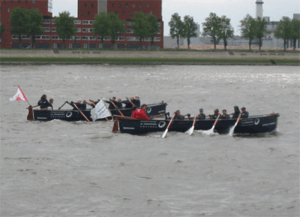
are four-oared vessels with pointed bow and sterns. The boat is steered by a sweep who stands in the stern and uses an oar like rudder to control the boat. During competition surf crews start on the beach and row through the surf to then proceed to a certain number of turning points (often referred to as the can). Crews then race back to the beach. As the boat nears the beach oars are raised and the boat is literally surfed to shore. Surf boat races are conducted on a weekly basis throughout the Australian summer. Hundreds of boat crews take part.
South Africa
Competitive rowing has been taking place on dams and rivers in South Africa since colonial times, but since May 2011 a growing number of people have been participating in recreational coastal rowing in Cape Town too. This has taken place mainly on False Bay from the naval base at Simon's Town, but there have also been regular outings to bodies of water elsewhere in the region, including the Berg and Breede Rivers, Langebaan and Hermanus lagoons, and the Atlantic ocean in the vicinity of Cape Point. The Cape Coastal Rowing fleet now includes a range of quads, doubles and singles.
Netherlands
In this country there is a vivid scene of "sloeproeien" which means rowing in lifeboats and Navy instruction longboats. This sport also means that traditional (original, old) boats are being preserved, restored and used in rowing races. As all boats are different, there is a system for correcting the time with a C-value to obtain more honest results.
Norway
Coastal rowing in Norway is primarily practiced in Christiania Roklub, Oslo and Kristiansand. There is an online community of coastal rowers in Norway called Team Coastal Rowing Norway based in Oslo. Norway has been increasingly active in participating at the world coastal rowing championships.
References
- ↑ "Archived copy". Archived from the original on 2009-04-27. Retrieved 2009-02-24.
- ↑ "Sound Rowers – Open Water Rowing and Paddling Club". Soundrowers.org. Retrieved 2016-08-03.
- ↑ "Cape Ann Rowing Club - Home of the Blackburn Challenge & Essex River Race". Blackburnchallenge.comSoundrowers.org. Retrieved 2016-08-03.
- ↑ "Home - Open Water Rowing National Championship". SOpenwaterracing.com. Retrieved 2016-08-03.
- ↑ "ClubLocarno - Home". Clubcarno.com. Retrieved 2016-08-03.
- ↑ "Home - Ocean to City - Cork Harbour Festival". Oceantocity.com. Retrieved 2016-08-03.
- ↑ "Naomhoga Chorcai". Naomhogachorcai.com. Retrieved 2016-08-03.
- ↑ "Archived copy". Archived from the original on 2008-05-10. Retrieved 2008-04-25.
- ↑ Cork, ARL Design Kinsale Cork, Web Design Cork, Graphic Design. "Irish Coastal Rowing - Irish Coastal Rowing Federation". Coastalrowing.net. Retrieved 2016-08-03.
- ↑ Nolan, Caroline. "Skiffie Worlds 2016". Strangfordlough.org. Retrieved 2016-08-03.